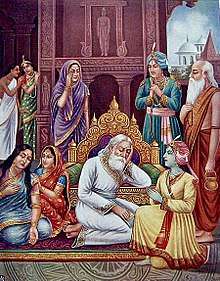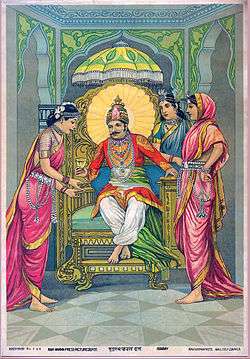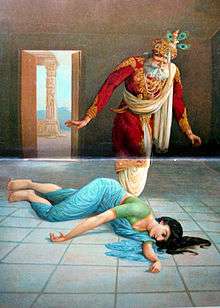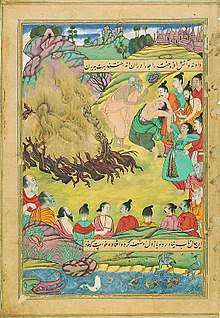Dasharatha
| Dasharatha | |
|---|---|
| Maharaja of Kosala | |
 King Dasharatha grieves inconsolably at his obligation to banish Rama to the forest | |
| Maharaja of Kosala | |
| Predecessor | Aja |
| Successor | Rama |
| Born |
Nemi Ayodhya, Kosala (present-day Uttar Pradesh, India) |
| Died | Ayodhya, Kosala (present-day Uttar Pradesh, India) |
| Consort(s) |
Kausalya Kaikeyi Sumitra |
| Issue |
Rama Bharatha Lakshmana Shatrughna |
| Dynasty | Raghuvanshi-Ikshvaku-Suryavanshi |
| Father | Aja |
| Mother | Indumati |
| Religion | Hinduism |
Dasharatha (Sanskrit: दशरथ, IAST Daśaratha) was a descendant of the Raghuvansha-Ikshvaku-Suryavansha dynasty and the Maharaja of Ayodhya as mentioned in the Hindu epic, the Ramayana.
Dasharatha was the son of Aja and Indumati. He had three wives; Kausalya, Kaikeyi and Sumitra and out of the union bore Rama (the principal character in the Ramayana), Bharatha, Lakshmana, Shatrughna.
Early life
Dasharatha was the son of King Aja of Ayodhya and Princess Indumati of Vidarbha. His birth name was Nemi, but he acquired the name Dasharatha as his chariot could move in all ten directions, fly as well as come down on earth and he could fight with ease in all these directions.
Dasharatha became king after his parents died. He was a great warrior who single-handedly conquered the whole earth with his prowess and defeated and slew many Asuras in war.
Dasharath had three queen consorts, namely, Kaushalya, Sumitra and Kaikeyi. Kaushalya was from the Kingdom of Magadha. Sumitra was from Kashi. Kaikeyi was from Kekeya Kingdom. Having an immense desire to beget a son, Dasharath promised Kaikeyi that the son she bore would succeed him as King of Ayodhya after she pleaded with him in the Kop Bhavan.
Yajna To Beget Sons

Dasharath performed two yajnas with the help of Sage Rishyasringa on the advice of Vasishtha.
One was Ashwamedha and other was Putrakameshti. It is said that Dasharath and Kaushalya had a daughter Shanta, who was Rishyashringa's wife. As the conclusion of the Yagna drew near, Agni sprang out from the yagnakunda (sacrificial fire pit) and handed Dasharatha a pot of kheer (payasa), advising him to distribute it among his queens.
Kaushalya ate half the kheer, Sumitra ate a quarter of it. Kaikeyi ate some and passed the pot back to Sumitra who consumed the kheer for the second time.
Thus the princes were conceived after the consumption of the kheer. Since Kaushalya had consumed the largest portion she gave birth to Rama. Kaikeyi gave birth to Bharata. Sumitra gave birth to Lakshmana and Shatrughna.
Boons To Kaikeyi

A maid of Queen Kaikeyi named Manthara convinced her that the throne of Maharaja Dasharatha belonged to her son Bharata and that her stepson—crown prince Rama (the hero of Ramayana)—should be exiled from the kingdom. The ugly maid also reminded her of the promise made to her by Dasharath when she saved him in the great war against the Asuras, that she was promised 2 boons and she could use them to make Bharata king.By crowning Rama as king, Dasharatha would be doing injustice to her as she wanted Bharata to be king.
Thus, after this conversation, Dasharatha is reminded by Kaikeyi about the two boons he has yet to fulfill for her. She talks of the time when she saved him from the demons during a celestial battle against Sambasura, an enemy of both Indra and Dasharatha. During a fierce battle between the two, the wheel of Dasharatha's chariot broke and Sambasura's arrow pierced the King's armor and lodged in his chest. Kaikeyi, who was acting as Dasharatha's charioteer, quickly repaired the broken wheel and then drove the chariot away from the battlefield. She nursed the wounded King back to health. Touched by her courage and timely service, Dasharatha offered her two boons. However, Kaikeyi chose to ask for those boons later. King Dasharatha is obliged to fulfill them. Kaikeyi demands that Bharata be crowned king and Rama be sent to the forest for fourteen years. Hearing this, Dasharatha falls into a swoon and passes the night in a pitiable condition in Kaikeyi's palace.
Killing Of Shravan Kumara
After Rama's departure to the forest, Dasharatha lies in his bed with a wailing Kaushalya. He suddenly remembers an incident which had occurred in the past. He narrates to Kaushalya about how, by accident, he had killed a young boy named Shravana mistaking him to be a deer. Dasharatha who was then a crown prince had gone hunting on the banks of River Saryu. He was an expert in hunting by determining the direction of sound and heard the gurgle of an animal drinking water. Mistaking it to be a Deer Dasharatha shot an arrow. He became mortified when he heard a human cry as the arrow found its target. Dasharatha hurried there to find a boy lying sprawled on the banks of the river with an arrow lodged in his chest. The boy rebukes Dasharatha for his unrighteous act and demands that he pull the arrow out of his chest. He also tells him to take the pitcher of water to his blind parents who must be waiting for him. The boy dies. Dasharatha approaches the blind couple and tells them about their son's unfortunate death. The parents, grief-stricken curse the prince: "Just as we are dying due to the separation from our beloved son, you too shall have the same fate." Dasharatha concludes the chapter by saying that his end is near and the curse has taken effect. The place where Dasharatha killed Shravana is now known as Shravan Kshetra.
Demise
Following his narration of Shravana, Dasharatha passes away in the night due to the pain and misery of his separation from Rama. His funeral rites were performed by Bharata and Shatrughna who were called back from Kekeya.

His Palace is in Faizabad district (U.P.) about 18.1 km away from Bilhar Ghat. It is beside the bank of the Sarayu River where he was cremated. This place is very devotional for Hindus.
References
External links
| Wikimedia Commons has media related to Dasaratha. |
.jpg)